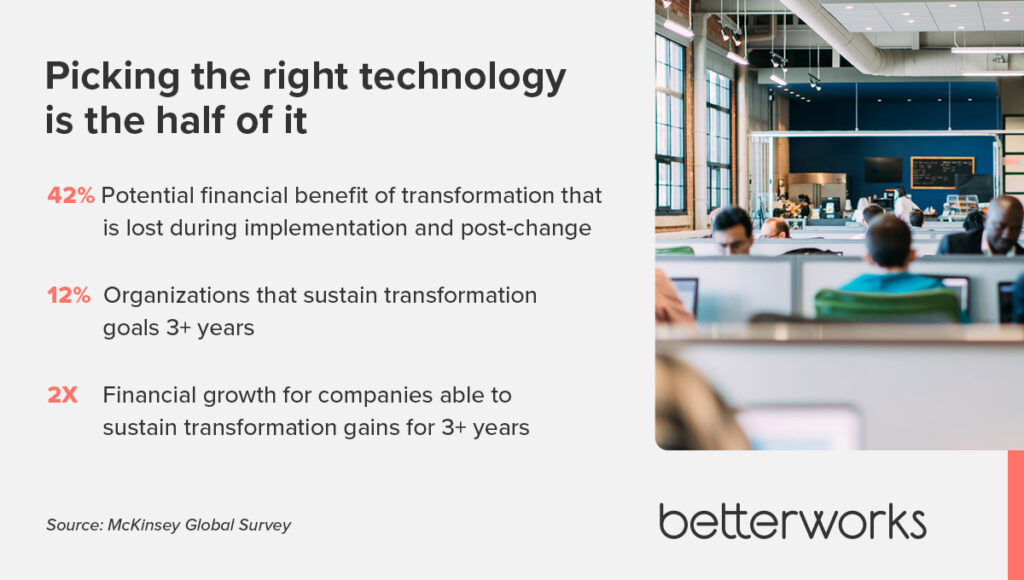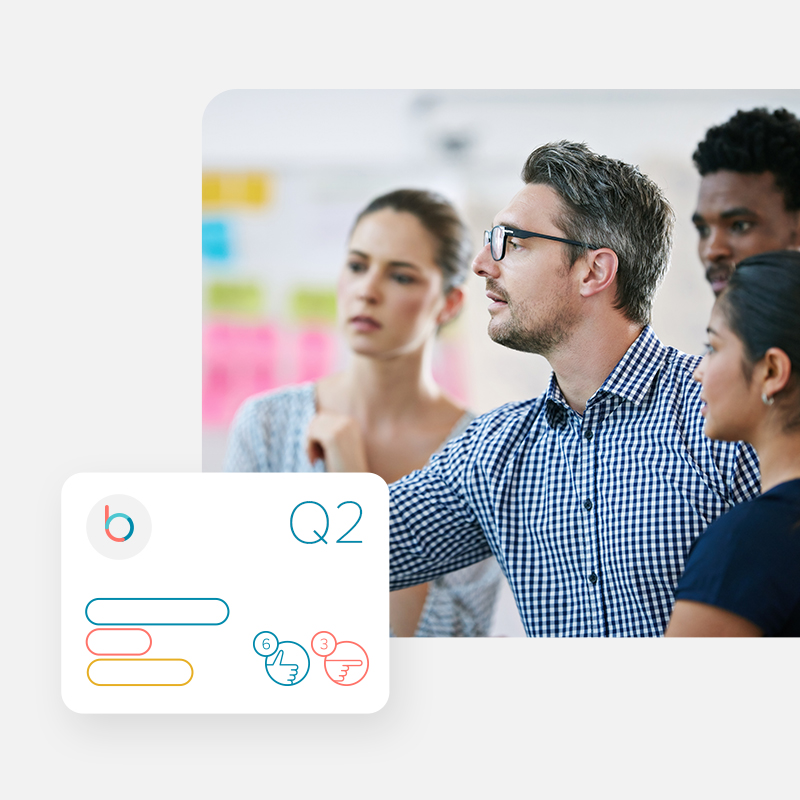Imagine you’re contemplating moving to a new geography. Before doing so, you’d consider issues like your short- and long-term goals, what you want to gain from the move, whether it makes sense to move now or wait for economic, career, or family reasons, and how you will gauge the success of your decision. You’d come up with your own list of needs, expectations, and risks rather than relying on a generic list you find online or what your friend did.
Not thinking through such a consequential change in your lifestyle could have unintended and even harmful consequences, financial or otherwise. Yet, this is precisely what some organizations do when changing their performance management processes. These mistakes can derail a new performance management program before it gets off the ground.
Having the right technology is essential, but it’s only half of the equation. The other half is doing the right planning beforehand to ensure you have the proper foundation and a smooth rollout and after launch to optimize your investment and achieve your intended goals. This is where having a partner with a dedicated professional services team can mean the difference between success and failure.
Too little, too much, or just right
Many customers who adopt a new performance management process will rely on nothing more than generic training and implementation guides from their technology partner. We find these wholly inadequate because they don’t address the specific needs most mid-size and enterprise companies have when implementing a new workforce process across the organization. On the other end of the spectrum are companies that use consulting firms to design and implement new tools and processes like performance management. This is a great option, albeit one that can be very expensive.
In our view, a sensible middle ground involves working with a partner with a dedicated, continuous performance management technology and a professional services arm with expertise in program design, planning, implementation, and dedicated support to ensure long-term success.
Why does this matter?
Only 12% of companies that have achieved their transformation goals are able to sustain them for more than three years, according to a McKinsey Global Survey. Additionally, 42% of the potential financial benefit is lost during execution and post-transformation. Companies that can sustain gains from their transformation for more than three years, however, experience financial growth twice that of their peers.

Clearly, investing in planning and program success is an up-front expenditure that will have significant payoffs.
Let’s look at the seven common planning and implementation mistakes that companies that can derail a new performance management program and how to avoid them.
Mistake #1: Lacking or weak executive sponsorship
Acquiring a proactive sponsor who will rally the executive team to lead by example is critical to success. Lacking or weak executive sponsorship is the number one reason change management programs fail. Beyond “signing the check” and saying “put it in place,” a proactive executive sponsor will help drive the program’s overall success by conveying its importance and priority to company leaders and the broader organization. Employees take their cues from leadership. If those at the top are not advocating for it, employees are less likely to see the value of the initiative and will consider it as just another program being foisted upon them.
Communicate from the top
With prompting from a proactive executive sponsor, company leaders can echo the value and expected outcomes of the investment and tie these to strategic business values. A steady drumbeat of communications is important here. Employees need to understand the new initiative and why it’s important so that when the performance management process launches, no one will be surprised, and employees will take it seriously. If leadership commits to being a part of the new process, it will also convey authenticity and build trust.

Mistake #2: Doing a pilot program with a limited number of employees
On the surface, a pilot may seem like a commonsense approach to test-driving a significant change initiative before deciding if and how to roll it out to the entire employee population. The problem is that small pilots with one hundred or even a few hundred people make the participants feel like guinea pigs in an experiment. They will not dedicate the time necessary to work with the new technology because they know the company is not 100 percent behind it and it may not be around in six months. This will skew the pilot test results. I have witnessed many failed pilots.
Develop the right program and roll it out in phases
If a big initiative, like a modern performance enablement process, comes from the top down and is well planned out, it can still be rolled out in phases if needed. Perhaps you start with a certain number of departments and introduce the program to additional functions on a rolling six-week schedule. Doing so can make the process more manageable for project leaders, allowing them to troubleshoot and adjust as necessary to make the rollout more streamlined for subsequent participants. This sends a far different message to employees than a six-month pilot with limited licenses to “test out” the process.
Mistake #3: Just automating your current performance management process
Transitioning from manual performance management processes, such as spreadsheets and Word docs, to an automated process will not yield better results if you are automating a bad process. Often, manual processes were not well thought out to begin with. They can be onerous for HR, managers, and employees. Likewise, if you have an automated but cumbersome solution, the problem often requires a redesign to be effective.
Companies that have implemented off-the-shelf performance management modules as part of a larger HCM system often find these all-in-one systems of record get performance management wrong. They aren’t designed to inspire and engage employees and cultivate performance. Adoption and data quality in an automated system may suffer just as much if it requires too many steps, isn’t intuitive, and forces managers and employees to log into an application to manage performance rather than enabling employees to do so in the flow of work — in the applications they use every day. Do not mistake process automation for better performance management.
Think about the outcomes you want
It’s worthwhile to first think about what you want to accomplish and then find the technology that best suits your needs. Companies should think about their performance management processes holistically. The right performance management process, what we at Betterworks call “performance enablement,” has an outsized impact on a company. It not only improves performance but can also improve culture, sense of belonging, job satisfaction, career development, retention, and many other factors. Ask yourself, “What are we looking to change? What problems are we trying to solve? Is it attrition, lack of accountability or transparency, anemic engagement and productivity, a need for regular feedback, or something else? It may be multiple factors.
Mistake #4: Not thoroughly designing a program
Closely related to No. 3 above is a failure to design a performance enablement program that your users will actually like and use regularly. Companies need to understand what is broken with their current system, what success looks like for different stakeholder groups, and what the future state should be.
My colleague Jamie Aitken, our VP of HR Transformation and a subject-matter expert in this area, wrote about this in How HR Leaders Can Design Better People Processes for the Future. HR leaders who often lead the charge tend to get bogged down in thinking about new processes and workflows. They fail to understand the user experience and make it the primary focus. Processes are designed for people. To put it simply, what pain points does Bob in Sales have with the current performance management process, where does he experience these, and how can you remove friction for him so that he uses the solution and sees its value?
Focus on design thinking
Companies have an opportunity to engage in design thinking to understand users’ pain points—that is, what is broken with the current system—and what success looks like for different stakeholder groups when designing that future state. Talking with others at all levels of your organization also conveys empathy. It will generate stronger buy-in for your change management initiative because people will feel they’ve been heard and their needs considered.

Avoiding mistakes at program launch
What are the most common mistakes that companies make during and after their performance management program launch, and what are the steps to take to avoid them to have a successful program long-term? Like the first four planning mistakes, these next three implementation mistakes are completely avoidable.
As with any significant change management initiative, you will be far better off with the help of a professional services team to guide you through the implementation and help you continuously improve your performance management processes over the long term. If you were preparing to go mountain climbing — and you had a moderate amount of experience — you would probably want to climb with people who know that particular terrain and have more experience than you. It’s no different when implementing and sustaining a new performance enablement process.
Mistake #5: Inadequate change management, communications, and training
According to Gartner’s 2023 State of the HR Technology Function, during human capital management (HCM) implementation, 75% of HR technology leaders gain additional consultative support, but less than half receive the change management resources they believe are important to the success of these complex projects.
Shifting to a new performance management process is not about launching a new set of tools and resources and emailing employees to take a few online training sessions before using the new system. Proper communications from various leaders and HR about what’s coming, why it matters, and how it will be implemented (for example, in phases) is a critical part of change management that companies sometimes overlook or rush. Without the right type and cadence of communication, your employees may be confused, resistant, frustrated, or even angry.

To generate high adoption of a new performance management process requires four critical elements, three of which I’ve mentioned previously: a proactive executive stakeholder, a well-designed process that meets your particular objectives, and the right communications. The fourth is adequate training. If users don’t understand how to best use and benefit from your new tool, chances are their adoption will be uneven at best. Managers and employees who are not in the habit of using their performance enablement tools frequently and regularly (in a lightweight way) will not get maximum advantage from them, and your business will not have the high quality of data generated by regular use of the software.

Strategize your communications and training
A professional services team can work with your internal team to help you establish clear policies and procedures around performance enablement and to set expectations with people managers and employees. Managers and employees should understand why you’re establishing the program, how they will benefit, and why it’s important to the company. Your solution partner should also be able to help you create effective, customized communications based on best practices and accounting for your culture. A best practice is to brand your program with a catchy name to help draw company-wide awareness of the project and its value.
Additionally, this team can design a program of online and live role-based training, workshops, and online guides for leadership, HR, managers, and employees based on best practices. Make sure your partner has a wide selection of testing plans, training materials, and communications that you can leverage during rollout.
Your internal implementation team should remain active for the first two months to ensure employees adopt the program. At that point, the designated program leader can take ownership.
Mistake #6: Failure to evolve the program over time
A performance enablement program deployment is not a one-and-done event. Companies can successfully launch and still experience challenges with adoption, manager effectiveness, coaching competency, and employees’ comfort levels with giving feedback, for example. As living organisms, organizations also evolve. Needs, focus, complexity, and even culture can change. Success may look different six or 12 months down the road.
Yet, some companies treat performance management processes as self-functioning and believe their program will bloom on its own without ongoing care. They may fail to review aspects of it, such as adoption and productivity, to determine if and how well their program works over time. This can cause an otherwise healthy program to wither over time.
Establish and track success metrics
Companies should establish their success metrics during the program design phase. An experienced partner will help you to not only understand what problems you’re trying to solve but will also work with you to define metrics to gauge success. They should build a metrics dashboard that allows you to easily track success over time to understand where you need to make adjustments and continue to help monitor ongoing business reviews. The dashboard might include:
- Increase in productivity
- Increase in goal alignment and achievement
- Increase in manager coaching competency
- Increase in eNPS
- Increase in employee feedback and use in performance reviews
- Improvement in tool adoption and usage
These metrics will be critical in proving that your decision to use a performance management platform was the right one. They will also give you vital information to assess the program’s impact when it comes time to decide whether to continue with it.

Mistake #7: No designated program lead
Who will run your performance enablement program after implementation? Companies that fail to designate a point person before the implementation phase are setting themselves up for failure. There should also be a governance structure. Without one, adapting to changing needs and circumstances to ensure continuous improvement will be difficult.
Assign a program lead and establish governance for sustainability
The program lead for your performance enablement process will be the primary point of contact with your external vendor during the implementation. Internally, they will be responsible for addressing evolving internal needs or changes, tracking the program’s success, meeting with internal stakeholder “champions,” keeping them abreast of changes, and communicating changes and updates across the company.
Establish or assign a governance committee that will work with the program lead. This group will address questions such as, “What’s working?” “What do we need to change?” “How’s it going?” “What problems are there?” The governance committee provides a framework for accountability, decision-making, resource allocation, prioritization, and implementation of changes. A program leader and a governance structure are essential to ensure you can sustain an effective performance enablement program that will always be optimized for your needs.
Getting the most from your performance management investment
Establishing the groundwork for success requires an implementation team, like the ones we have at Betterworks, that will focus on ensuring you have high adoption. This includes implementing best practices, taking care with program design, defining success metrics, and creating successful change management. The partner you work with should provide a program architect who will take you through the steps for successful implementation and a customer success manager who will continue to work with you on troubleshooting, optimizing the tools and process, and customization requests once your program is live.
We recommend the following steps to drive a high-adoption program: securing executive sponsorship, effective and customized communications and training, embedding performance management across processes, having clear guidelines and expectations, and enlisting program champions to assist you in championing the program or passing the baton to a program manager.

Betterworks’ scorecard
The Betterworks Professional Services team has completed nearly 1,000 implementations for customers of all sizes and complexities and maintains a 78+ NPS for onboarding customers.
We offer:
- A proven methodology used for customers with 150 – 150,000 EEs
- High-touch support through implementation and after launch
- Enterprise-grade services for all sizes of organizations
- Different service offerings custom-tailored to your needs
- Enterprise-grade learning content to help drive adoption
- Training services for level of support (train the trainer, BW University, end-user)
- A global implementation team
A solid foundation for performance management
If you avoid these seven mistakes, you are well on the way to setting yourself up for a successful performance enablement process. These actions may feel daunting to accomplish, but if you work with a partner with expertise in enterprise-level change management and program implementation, you will lighten your burden and have a far greater probability that your investment of time, people resources, and funds will yield a thriving workforce that is aligned with the organization’s strategic business goals.
To learn more about Betterworks solutions and professional services, visit www.betterworks.com.
Rob Buzinski is the vice president of Professional Services at Betterworks. As an experienced client services leader and 20-plus-year veteran of the enterprise cloud services industry, Rob has worked with customers and prospects during all phases of their planning and implementation journey to drive business results and employee engagement. He has architected elegant end-to-end solutions to help customers achieve their short-and long-term goals and realize enduring business value.





